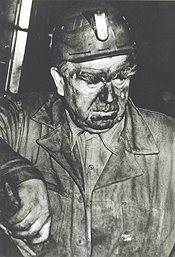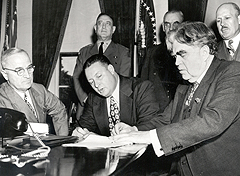John L. Lewis: A Giant Among Labor Leaders
June 30, 2006
(This article was first published in the July/August 2006 issue of The American Postal Worker magazine.)
A dominant figure in labor history, John L. Lewis was the founding force behind several national unions and a leader of the United Mine Workers of America (UMWA) for more than 40 years. In aiding the union struggle for better wages and benefits, he confronted presidents, corporate powers and even other unions to shape and expand the union movement during the decades when labor made its greatest gains.
 Born in 1880 to Welsh immigrants in the coal-mining town of Lucas, IA, John Llewellyn Lewis followed his father and brother into the mines after he completed his formal schooling at the age of 16.While working at the Big Hill mine, Lewis served as the recording secretary for the UMWA local. In his spare time, he studied acting at a local theater, where he developed a flair for oratory.
Born in 1880 to Welsh immigrants in the coal-mining town of Lucas, IA, John Llewellyn Lewis followed his father and brother into the mines after he completed his formal schooling at the age of 16.While working at the Big Hill mine, Lewis served as the recording secretary for the UMWA local. In his spare time, he studied acting at a local theater, where he developed a flair for oratory.
In 1901, at age 21, he left Iowa to “ride the rails” out West, working as an unskilled laborer and seeing firsthand the hardships faced by a variety of workers. Lewis returned to the Midwest and the mines in 1905, and in 1907 married Myrta Edith Bell. The couple moved to Panama, IL, where he soon became president of UMWA Local 1475.
Lewis’ effort to get the Illinois legislature to pass workers’ compensation and mine-safety legislation caught the attention of Samuel Gompers, president of the American Federation of Labor (AFL), who made the mine-worker leader a national organizer. Lewis proved to be a gifted strategist and negotiator, and was credited with winning significant wage increases for workers in the Midwest’s bituminous coal fields.
Lewis was a large and forceful figure. “Dour-visaged, thickly eyebrowed, richly maned, his 230-pound bulk always impeccably tailored,” noted historian David Kennedy, “Lewis was a man of ursine appearance and volcanic personality, a no-holds barred advocate for labor and a fearsome adversary.”
Lewis rose quickly through the union ranks and in late1919 became president of the UMWA, which was the largest and most influential union in the country. Within a few years of his taking the helm, UMWA membership had swelled to 500,000.
The 1920s were a tough time for American unions, who had no legally sanctioned collective bargaining rights. Nonetheless, Lewis leveraged the nation’s dependence on coal to guide UMWA miners through a successful five-month strike in 1920.
When the Great Depression arrived in 1929, however, miners were among the working families who suffered: If they could find any work at all, miners who had earned $7 a day before the crash were lucky to reap $1for the same labor. By 1933, UMWA membership had fallen to 75,000.
Lewis determined that political action was needed to level the playing field for organizing, and though he had always been a Republican, he joined other union leaders in supporting Democrat Franklin D. Roosevelt in the1932 presidential election. Making good on his campaign promises, FDR in 1933 signed into law the National Recovery Act (NRA), which was crafted to stabilize industrial production and employment and, for the first time, to guarantee workers the right to organize and bargain collectively over the terms and conditions of their employment.
When the NRA took effect, Lewis kicked off an all-out organizing campaign that soon brought 92 percent of the nation’s coal miners into the union fold, with UMWA membership quickly rebounding, including more than 300,000 new members in just two months. The new labor protections also helped other unions grow dramatically after 1933.
The Rights of Labor
Lewis deeply believed that the union movement should do more than merely look after its own membership and their families; labor should help all workers achieve a middle-class existence.
 Lewis used his leadership of the UMWA to press the AFL to organize workers in other mass-production industries. The AFL had been an amalgamation of mostly conservative unions representing workers in skilled trades, and it rejected the efforts of Lewis and other progressive unionists to open its ranks to unskilled industrial workers, as well as to women and minorities. (The UMWA had barred discrimination based on race, religion, and national origin since its founding in 1890.)
Lewis used his leadership of the UMWA to press the AFL to organize workers in other mass-production industries. The AFL had been an amalgamation of mostly conservative unions representing workers in skilled trades, and it rejected the efforts of Lewis and other progressive unionists to open its ranks to unskilled industrial workers, as well as to women and minorities. (The UMWA had barred discrimination based on race, religion, and national origin since its founding in 1890.)
Lewis’ efforts to make the AFL more representative of working America was rejected at the federation’s 1933 convention. In 1934, however, Lewis got the AFL to support the principle of organizing on an industrial basis.
But by the following year, Lewis had grown convinced that AFL leadership was backpedaling on its promise to organize and charter industrial unions. The climax to a three-day debate on the issue at the AFL convention in 1935 was a floor scuffle between Lewis and carpenters’ union president William Hutcheson.
Shortly after the convention, Lewis led the presidents of seven other unions in the creation of a Committee for Industrial Organization, designed to work within the framework of the AFL. When the action was denounced by the federation’s old guard, Lewis resigned his vice presidency. (When the AFL convention met in late 1936, none of the eight industrial unions appeared.)
The industrial committee — the original “CIO” — sent hundreds of UMWA representatives into the nation’s factories, helping to organize workers in steel, automobile, rubber, and other industries, and leading to the creation of such unions as the United Steelworkers of America and the United Autoworkers of America.
Without Lewis’ leadership, “it is doubtful whether these campaigns would have succeeded,” notes a tribute to him on the AFL-CIO Web site. “Lewis assigned his own staff to assist each drive, remained in constant communication with them all, and personally negotiated the agreements with General Motors and U.S. Steel.”
Charismatic Leadership
Already considered the driving force behind the “Committee,” Lewis became president of the breakaway labor federation, the Congress of Industrial Organizations (the “CIO” that survives to this day), at its founding convention in 1938. His bold successes in demands to the corporate world and his gift for stirring oratory led millions to the labor movement.
“I have pleaded (labor’s) case, not in the quavering tones of a feeble mendicant asking alms,” Lewis once said, “but in the thundering voice of the captain of a mighty host, demanding the rights to which free men are entitled.”
During World War II, however, Lewis’ no-holds-barred approach to advancing the union cause led to nationwide public dismay when a half-million miners walked off the job, causing power shortages and closing steel mills needed for war production.
He had also earned the enmity of many unionists when he broke with FDR to support GOP presidential candidate Wendell Willkie in 1940. That added to American union leadership’s growing disenchantment with Lewis’ autocratic style, and prompted him to step aside as CIO president. In 1942, he pulled the UMWA out of the industrial union movement he had been so instrumental in creating.
For two decades, Lewis and the UMWA won steady wage and benefit increases for union miners, even as oil began to replace coal as the nation’s primary source of energy. Perhaps Lewis’ most important achievement for the miners he represented was a historic agreement in 1948 that established the UMWA Welfare and Retirement Fund, which to this day provides medical and pension benefits for union coal miners, financed in part by a royalty on every ton of coal mined.
The UMWA, however, began a long, persistent decline after World War II, and Lewis retired as the union’s president in 1960. In 1964, President Lyndon Johnson awarded him the Presidential Medal of Freedom, the nation’s highest civilian decoration. Lewis remained Chairman of the UMWA Welfare and Retirement Fund until he died in 1969 at his home in Alexandria, VA.



